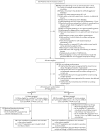Therapeutic hypothermia after out-of-hospital cardiac arrest in children
- PMID: 25913022
- PMCID: PMC4470472
- DOI: 10.1056/NEJMoa1411480
Therapeutic hypothermia after out-of-hospital cardiac arrest in children
Abstract
Background: Therapeutic hypothermia is recommended for comatose adults after witnessed out-of-hospital cardiac arrest, but data about this intervention in children are limited.
Methods: We conducted this trial of two targeted temperature interventions at 38 children's hospitals involving children who remained unconscious after out-of-hospital cardiac arrest. Within 6 hours after the return of circulation, comatose patients who were older than 2 days and younger than 18 years of age were randomly assigned to therapeutic hypothermia (target temperature, 33.0°C) or therapeutic normothermia (target temperature, 36.8°C). The primary efficacy outcome, survival at 12 months after cardiac arrest with a Vineland Adaptive Behavior Scales, second edition (VABS-II), score of 70 or higher (on a scale from 20 to 160, with higher scores indicating better function), was evaluated among patients with a VABS-II score of at least 70 before cardiac arrest.
Results: A total of 295 patients underwent randomization. Among the 260 patients with data that could be evaluated and who had a VABS-II score of at least 70 before cardiac arrest, there was no significant difference in the primary outcome between the hypothermia group and the normothermia group (20% vs. 12%; relative likelihood, 1.54; 95% confidence interval [CI], 0.86 to 2.76; P=0.14). Among all the patients with data that could be evaluated, the change in the VABS-II score from baseline to 12 months was not significantly different (P=0.13) and 1-year survival was similar (38% in the hypothermia group vs. 29% in the normothermia group; relative likelihood, 1.29; 95% CI, 0.93 to 1.79; P=0.13). The groups had similar incidences of infection and serious arrhythmias, as well as similar use of blood products and 28-day mortality.
Conclusions: In comatose children who survived out-of-hospital cardiac arrest, therapeutic hypothermia, as compared with therapeutic normothermia, did not confer a significant benefit in survival with a good functional outcome at 1 year. (Funded by the National Heart, Lung, and Blood Institute and others; THAPCA-OH ClinicalTrials.gov number, NCT00878644.).
Figures


Comment in
-
Emergency cooling doesn't improve outcomes in children with cardiac arrest, study shows.BMJ. 2015 Apr 27;350:h2245. doi: 10.1136/bmj.h2245. BMJ. 2015. PMID: 25921335 No abstract available.
-
Cardiac resuscitation: No benefit of therapeutic hypothermia after cardiac arrest in children.Nat Rev Cardiol. 2015 Jun;12(6):318. doi: 10.1038/nrcardio.2015.73. Epub 2015 May 12. Nat Rev Cardiol. 2015. PMID: 25962975 No abstract available.
-
Therapeutic Hypothermia in Children.N Engl J Med. 2015 Sep 3;373(10):980. doi: 10.1056/NEJMc1508693. N Engl J Med. 2015. PMID: 26332558 No abstract available.
-
Therapeutic Hypothermia in Children.N Engl J Med. 2015 Sep 3;373(10):979. doi: 10.1056/NEJMc1508693. N Engl J Med. 2015. PMID: 26332559 No abstract available.
-
Therapeutic Hypothermia in Children.N Engl J Med. 2015 Sep 3;373(10):979-80. doi: 10.1056/NEJMc1508693. N Engl J Med. 2015. PMID: 26332560 Free PMC article. No abstract available.
References
-
- Young KD, Gausche-Hill M, McClung CD, Lewis RJ. A prospective, population-based study of the epidemiology and outcome of out-of-hospital pediatric cardiopulmonary arrest. Pediatrics. 2004;114:157–64. - PubMed
-
- Donoghue AJ, Nadkarni V, Berg RA, et al. Out-of-hospital pediatric cardiac arrest: an epidemiologic review and assessment of current knowledge. Ann Emerg Med. 2005;46:512–22. - PubMed
-
- The Hypothermia after Cardiac Arrest Study Group. Mild therapeutic hypothermia to improve the neurologic outcome after cardiac arrest. N Engl J Med. 2002;346:549–56. - PubMed
-
- Bernard SA, Gray TW, Buist MD, et al. Treatment of comatose survivors of out-of-hospital cardiac arrest with induced hypothermia. N Engl J Med. 2002;346:557–63. - PubMed
Publication types
MeSH terms
Associated data
Grants and funding
- UL1 TR000433/TR/NCATS NIH HHS/United States
- U01HD049934/HD/NICHD NIH HHS/United States
- R34 HD050531/HD/NICHD NIH HHS/United States
- U10HD049981/HD/NICHD NIH HHS/United States
- U03MC00003/PHS HHS/United States
- U10 HD050096/HD/NICHD NIH HHS/United States
- U03MC00008/PHS HHS/United States
- HD044955/HD/NICHD NIH HHS/United States
- RL1 HD107773/HD/NICHD NIH HHS/United States
- U03MC00001/PHS HHS/United States
- U10HD049983/HD/NICHD NIH HHS/United States
- HL094339/HL/NHLBI NIH HHS/United States
- U10HD050012/HD/NICHD NIH HHS/United States
- R21 HD044955/HD/NICHD NIH HHS/United States
- U10HD049945/HD/NICHD NIH HHS/United States
- U03MC00006/PHS HHS/United States
- U01 HL094339/HL/NHLBI NIH HHS/United States
- U10 HD050012/HD/NICHD NIH HHS/United States
- U10 HD049945/HD/NICHD NIH HHS/United States
- HL094345/HL/NHLBI NIH HHS/United States
- UG1 HD050096/HD/NICHD NIH HHS/United States
- K23 NS075363/NS/NINDS NIH HHS/United States
- U10 HD049981/HD/NICHD NIH HHS/United States
- HD050531/HD/NICHD NIH HHS/United States
- U01 HL094345/HL/NHLBI NIH HHS/United States
- U10 HD049983/HD/NICHD NIH HHS/United States
- U03MC00007/PHS HHS/United States
- U10HD050096/HD/NICHD NIH HHS/United States
- U01 HD049934/HD/NICHD NIH HHS/United States
- U10HD500009/HD/NICHD NIH HHS/United States
LinkOut - more resources
Full Text Sources
Other Literature Sources
Medical
